University Engineering Modeling and Simulation Homework Assignment
VerifiedAdded on 2023/01/09
|10
|1536
|67
Homework Assignment
AI Summary
This document presents a comprehensive solution to an engineering modeling and simulation assignment. It includes MATLAB code and outputs for several tasks, such as finding integer solutions to a quadratic equation, calculating the value of 'g' based on velocity and radius of curvature, simulating contamination of ponds using differential equations, determining the natural frequency of a vibrating system using mass and stiffness matrices, calculating the range of a projectile in both ideal and air resistance scenarios. The solutions cover a range of engineering concepts, including dynamics, projectile motion, and system analysis, providing a detailed understanding of the problem-solving process using MATLAB.
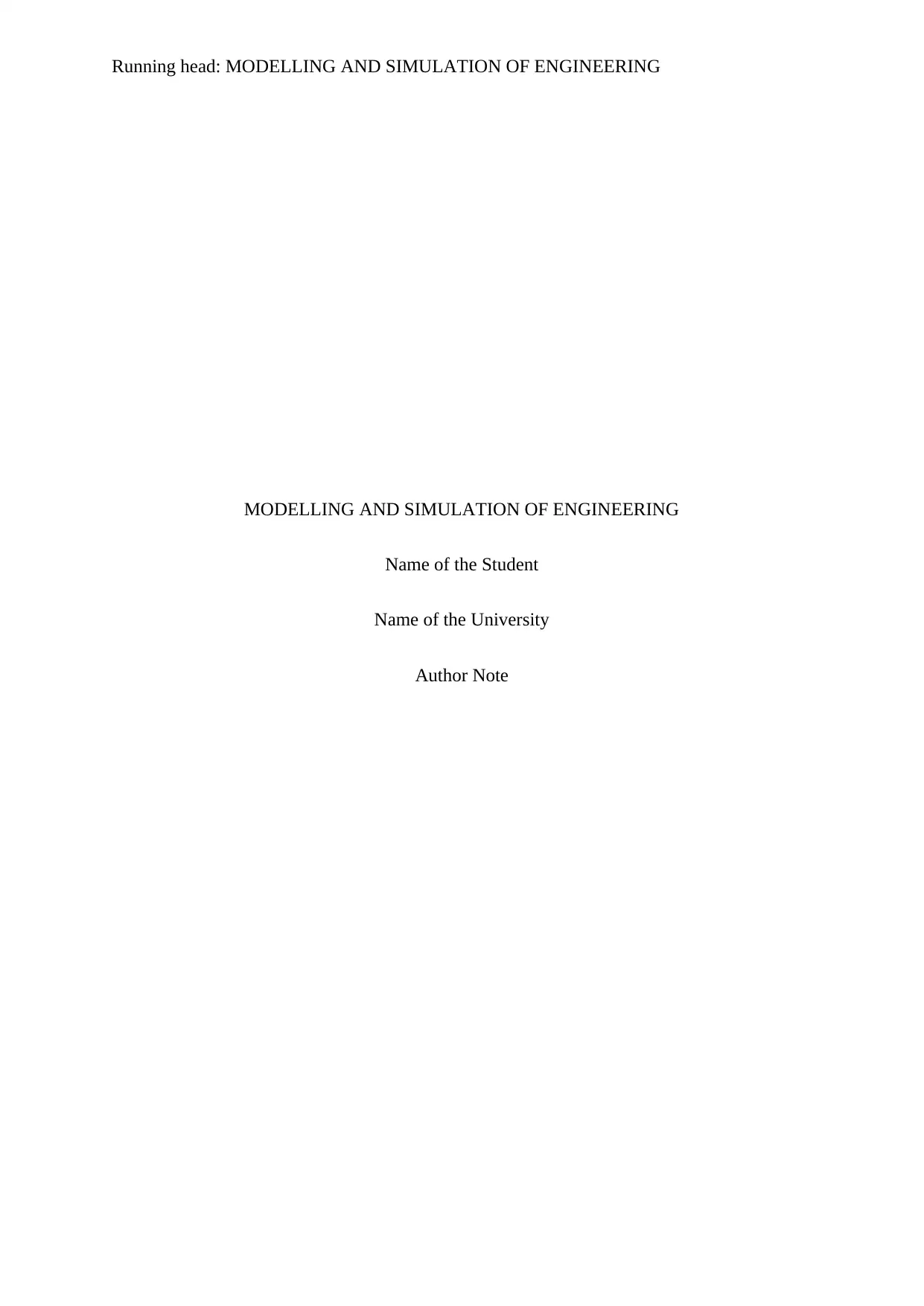
Running head: MODELLING AND SIMULATION OF ENGINEERING
MODELLING AND SIMULATION OF ENGINEERING
Name of the Student
Name of the University
Author Note
MODELLING AND SIMULATION OF ENGINEERING
Name of the Student
Name of the University
Author Note
Paraphrase This Document
Need a fresh take? Get an instant paraphrase of this document with our AI Paraphraser
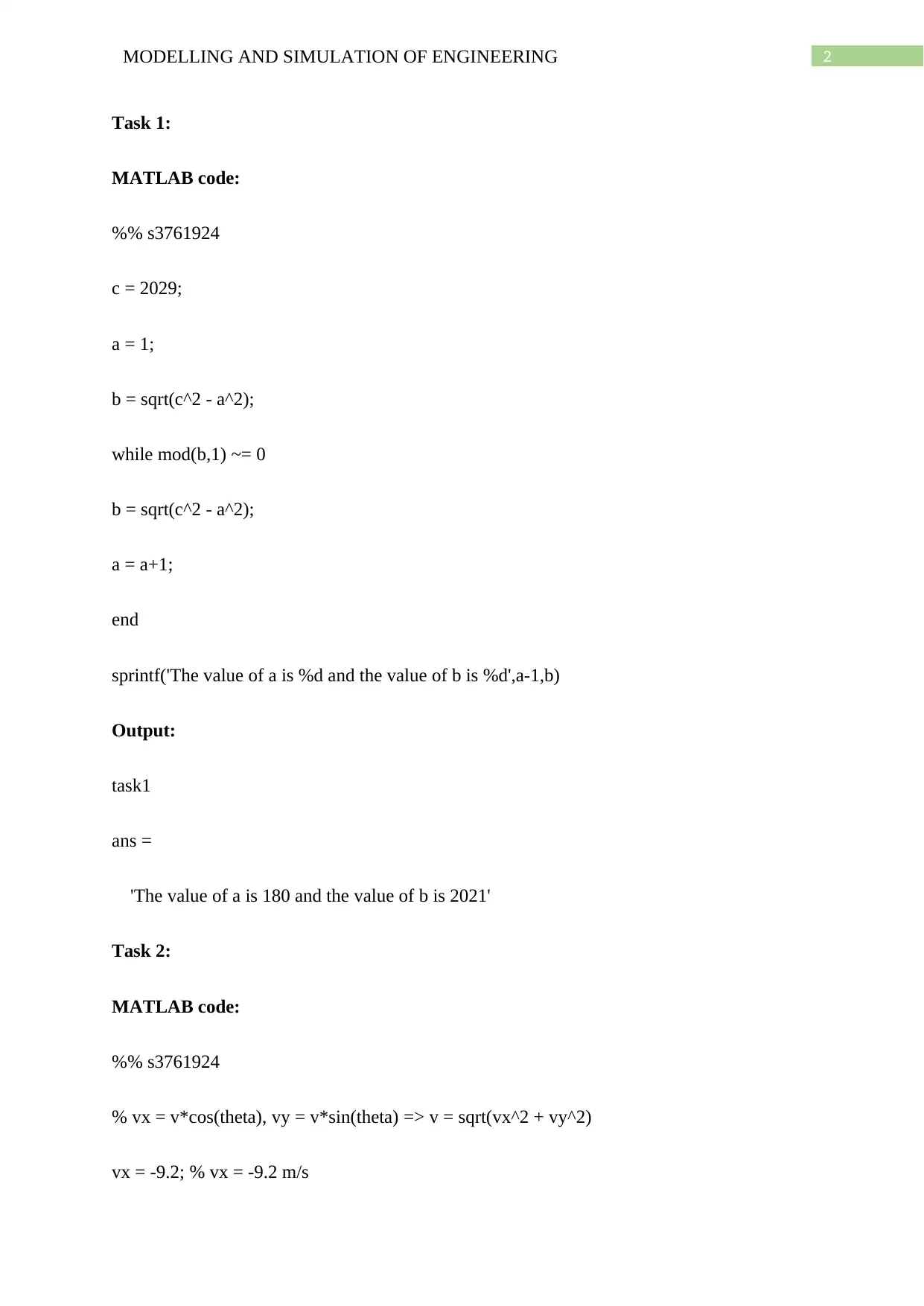
2MODELLING AND SIMULATION OF ENGINEERING
Task 1:
MATLAB code:
%% s3761924
c = 2029;
a = 1;
b = sqrt(c^2 - a^2);
while mod(b,1) ~= 0
b = sqrt(c^2 - a^2);
a = a+1;
end
sprintf('The value of a is %d and the value of b is %d',a-1,b)
Output:
task1
ans =
'The value of a is 180 and the value of b is 2021'
Task 2:
MATLAB code:
%% s3761924
% vx = v*cos(theta), vy = v*sin(theta) => v = sqrt(vx^2 + vy^2)
vx = -9.2; % vx = -9.2 m/s
Task 1:
MATLAB code:
%% s3761924
c = 2029;
a = 1;
b = sqrt(c^2 - a^2);
while mod(b,1) ~= 0
b = sqrt(c^2 - a^2);
a = a+1;
end
sprintf('The value of a is %d and the value of b is %d',a-1,b)
Output:
task1
ans =
'The value of a is 180 and the value of b is 2021'
Task 2:
MATLAB code:
%% s3761924
% vx = v*cos(theta), vy = v*sin(theta) => v = sqrt(vx^2 + vy^2)
vx = -9.2; % vx = -9.2 m/s
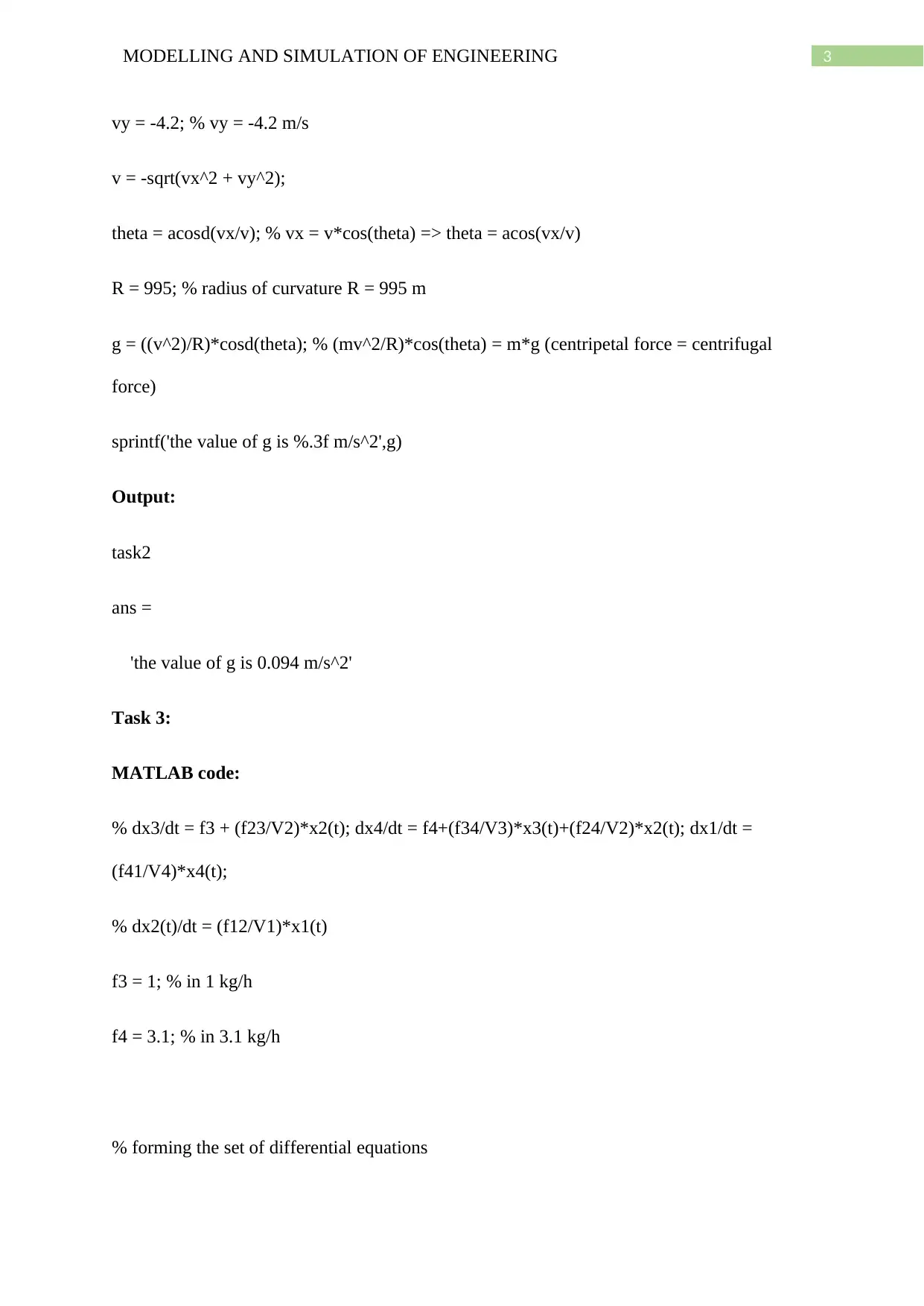
3MODELLING AND SIMULATION OF ENGINEERING
vy = -4.2; % vy = -4.2 m/s
v = -sqrt(vx^2 + vy^2);
theta = acosd(vx/v); % vx = v*cos(theta) => theta = acos(vx/v)
R = 995; % radius of curvature R = 995 m
g = ((v^2)/R)*cosd(theta); % (mv^2/R)*cos(theta) = m*g (centripetal force = centrifugal
force)
sprintf('the value of g is %.3f m/s^2',g)
Output:
task2
ans =
'the value of g is 0.094 m/s^2'
Task 3:
MATLAB code:
% dx3/dt = f3 + (f23/V2)*x2(t); dx4/dt = f4+(f34/V3)*x3(t)+(f24/V2)*x2(t); dx1/dt =
(f41/V4)*x4(t);
% dx2(t)/dt = (f12/V1)*x1(t)
f3 = 1; % in 1 kg/h
f4 = 3.1; % in 3.1 kg/h
% forming the set of differential equations
vy = -4.2; % vy = -4.2 m/s
v = -sqrt(vx^2 + vy^2);
theta = acosd(vx/v); % vx = v*cos(theta) => theta = acos(vx/v)
R = 995; % radius of curvature R = 995 m
g = ((v^2)/R)*cosd(theta); % (mv^2/R)*cos(theta) = m*g (centripetal force = centrifugal
force)
sprintf('the value of g is %.3f m/s^2',g)
Output:
task2
ans =
'the value of g is 0.094 m/s^2'
Task 3:
MATLAB code:
% dx3/dt = f3 + (f23/V2)*x2(t); dx4/dt = f4+(f34/V3)*x3(t)+(f24/V2)*x2(t); dx1/dt =
(f41/V4)*x4(t);
% dx2(t)/dt = (f12/V1)*x1(t)
f3 = 1; % in 1 kg/h
f4 = 3.1; % in 3.1 kg/h
% forming the set of differential equations
⊘ This is a preview!⊘
Do you want full access?
Subscribe today to unlock all pages.

Trusted by 1+ million students worldwide
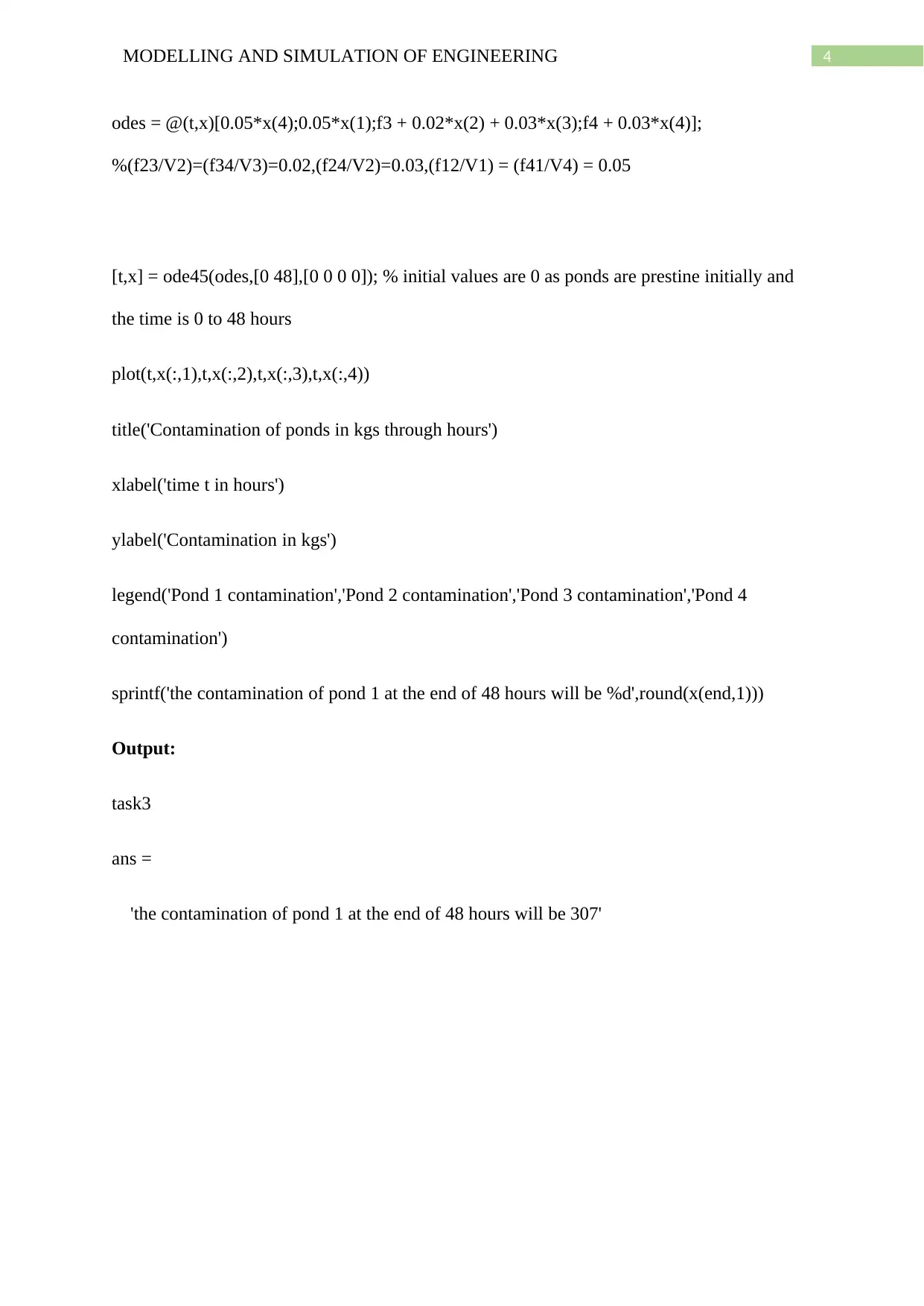
4MODELLING AND SIMULATION OF ENGINEERING
odes = @(t,x)[0.05*x(4);0.05*x(1);f3 + 0.02*x(2) + 0.03*x(3);f4 + 0.03*x(4)];
%(f23/V2)=(f34/V3)=0.02,(f24/V2)=0.03,(f12/V1) = (f41/V4) = 0.05
[t,x] = ode45(odes,[0 48],[0 0 0 0]); % initial values are 0 as ponds are prestine initially and
the time is 0 to 48 hours
plot(t,x(:,1),t,x(:,2),t,x(:,3),t,x(:,4))
title('Contamination of ponds in kgs through hours')
xlabel('time t in hours')
ylabel('Contamination in kgs')
legend('Pond 1 contamination','Pond 2 contamination','Pond 3 contamination','Pond 4
contamination')
sprintf('the contamination of pond 1 at the end of 48 hours will be %d',round(x(end,1)))
Output:
task3
ans =
'the contamination of pond 1 at the end of 48 hours will be 307'
odes = @(t,x)[0.05*x(4);0.05*x(1);f3 + 0.02*x(2) + 0.03*x(3);f4 + 0.03*x(4)];
%(f23/V2)=(f34/V3)=0.02,(f24/V2)=0.03,(f12/V1) = (f41/V4) = 0.05
[t,x] = ode45(odes,[0 48],[0 0 0 0]); % initial values are 0 as ponds are prestine initially and
the time is 0 to 48 hours
plot(t,x(:,1),t,x(:,2),t,x(:,3),t,x(:,4))
title('Contamination of ponds in kgs through hours')
xlabel('time t in hours')
ylabel('Contamination in kgs')
legend('Pond 1 contamination','Pond 2 contamination','Pond 3 contamination','Pond 4
contamination')
sprintf('the contamination of pond 1 at the end of 48 hours will be %d',round(x(end,1)))
Output:
task3
ans =
'the contamination of pond 1 at the end of 48 hours will be 307'
Paraphrase This Document
Need a fresh take? Get an instant paraphrase of this document with our AI Paraphraser
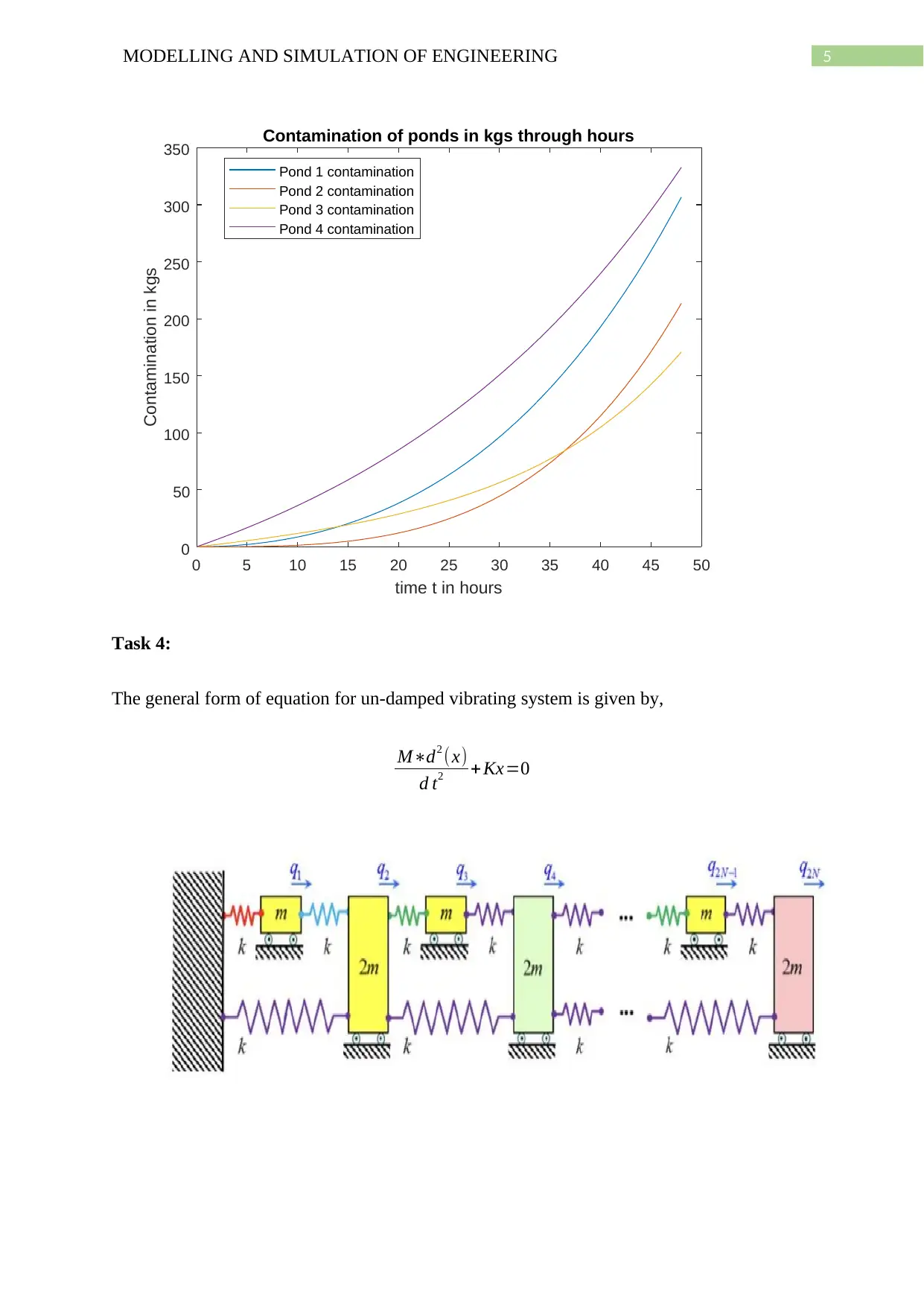
5MODELLING AND SIMULATION OF ENGINEERING
0 5 10 15 20 25 30 35 40 45 50
time t in hours
0
50
100
150
200
250
300
350
Contamination in kgs
Contamination of ponds in kgs through hours
Pond 1 contamination
Pond 2 contamination
Pond 3 contamination
Pond 4 contamination
Task 4:
The general form of equation for un-damped vibrating system is given by,
M∗d2 (x)
d t2 + Kx=0
0 5 10 15 20 25 30 35 40 45 50
time t in hours
0
50
100
150
200
250
300
350
Contamination in kgs
Contamination of ponds in kgs through hours
Pond 1 contamination
Pond 2 contamination
Pond 3 contamination
Pond 4 contamination
Task 4:
The general form of equation for un-damped vibrating system is given by,
M∗d2 (x)
d t2 + Kx=0
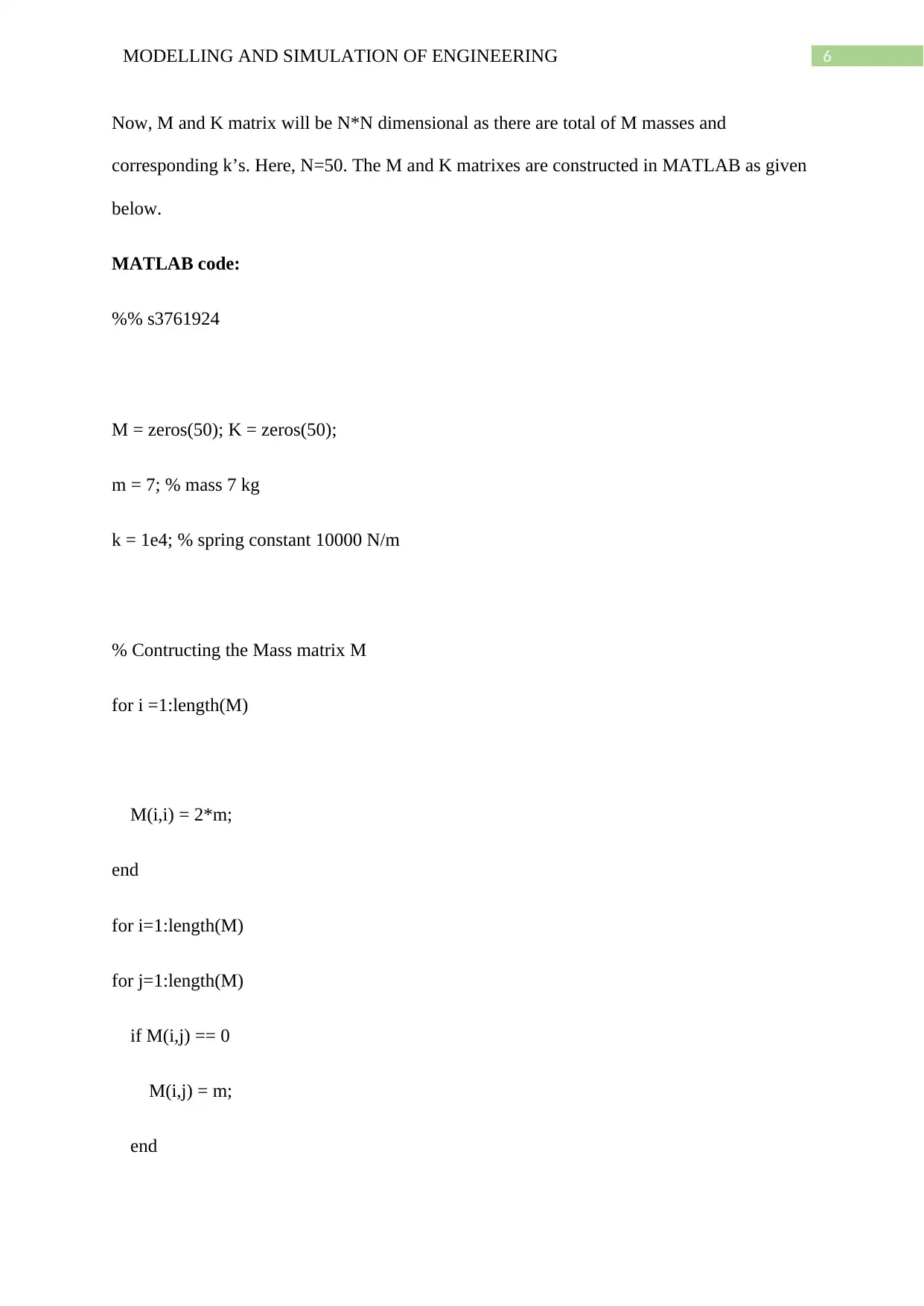
6MODELLING AND SIMULATION OF ENGINEERING
Now, M and K matrix will be N*N dimensional as there are total of M masses and
corresponding k’s. Here, N=50. The M and K matrixes are constructed in MATLAB as given
below.
MATLAB code:
%% s3761924
M = zeros(50); K = zeros(50);
m = 7; % mass 7 kg
k = 1e4; % spring constant 10000 N/m
% Contructing the Mass matrix M
for i =1:length(M)
M(i,i) = 2*m;
end
for i=1:length(M)
for j=1:length(M)
if M(i,j) == 0
M(i,j) = m;
end
Now, M and K matrix will be N*N dimensional as there are total of M masses and
corresponding k’s. Here, N=50. The M and K matrixes are constructed in MATLAB as given
below.
MATLAB code:
%% s3761924
M = zeros(50); K = zeros(50);
m = 7; % mass 7 kg
k = 1e4; % spring constant 10000 N/m
% Contructing the Mass matrix M
for i =1:length(M)
M(i,i) = 2*m;
end
for i=1:length(M)
for j=1:length(M)
if M(i,j) == 0
M(i,j) = m;
end
⊘ This is a preview!⊘
Do you want full access?
Subscribe today to unlock all pages.

Trusted by 1+ million students worldwide
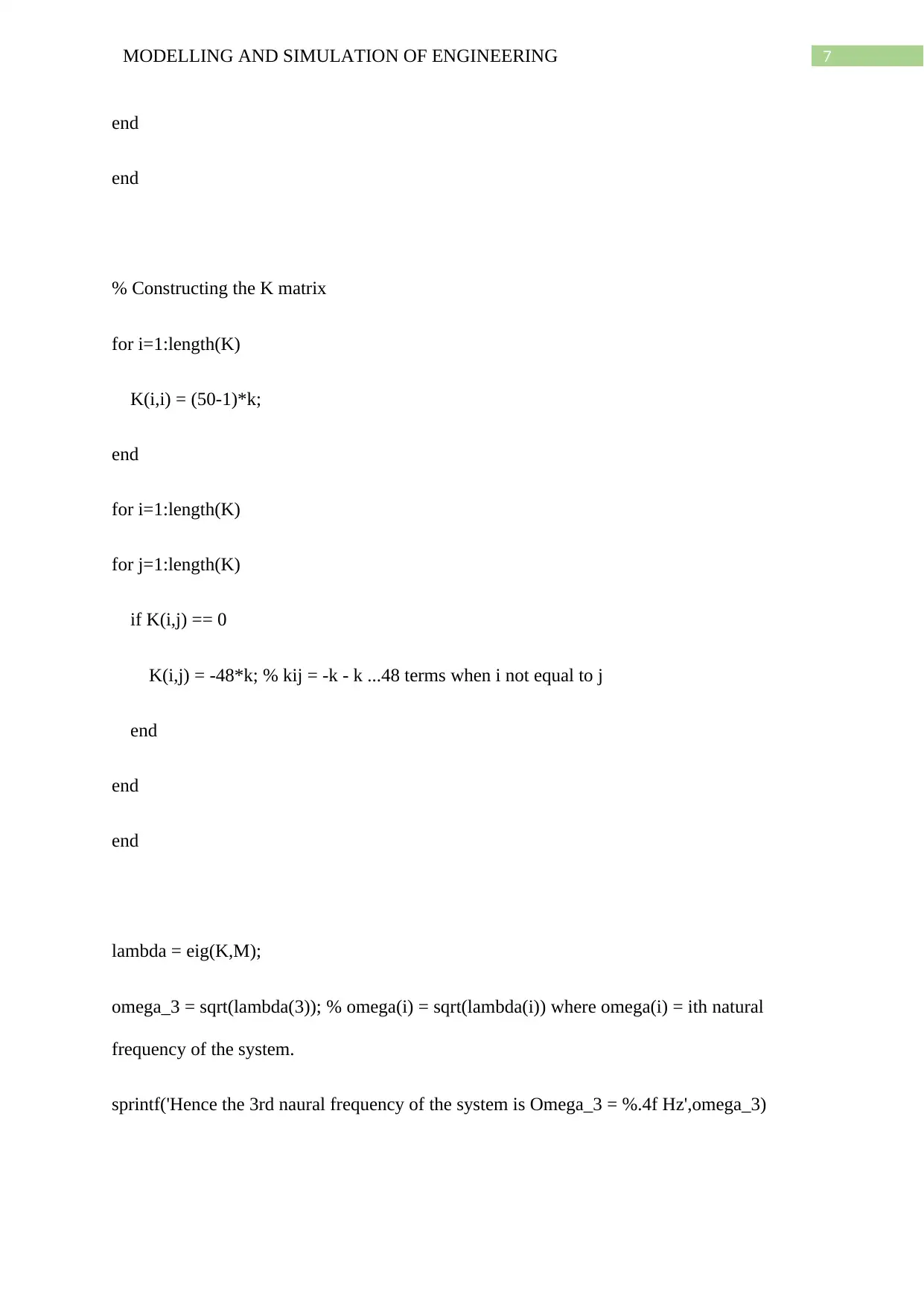
7MODELLING AND SIMULATION OF ENGINEERING
end
end
% Constructing the K matrix
for i=1:length(K)
K(i,i) = (50-1)*k;
end
for i=1:length(K)
for j=1:length(K)
if K(i,j) == 0
K(i,j) = -48*k; % kij = -k - k ...48 terms when i not equal to j
end
end
end
lambda = eig(K,M);
omega_3 = sqrt(lambda(3)); % omega(i) = sqrt(lambda(i)) where omega(i) = ith natural
frequency of the system.
sprintf('Hence the 3rd naural frequency of the system is Omega_3 = %.4f Hz',omega_3)
end
end
% Constructing the K matrix
for i=1:length(K)
K(i,i) = (50-1)*k;
end
for i=1:length(K)
for j=1:length(K)
if K(i,j) == 0
K(i,j) = -48*k; % kij = -k - k ...48 terms when i not equal to j
end
end
end
lambda = eig(K,M);
omega_3 = sqrt(lambda(3)); % omega(i) = sqrt(lambda(i)) where omega(i) = ith natural
frequency of the system.
sprintf('Hence the 3rd naural frequency of the system is Omega_3 = %.4f Hz',omega_3)
Paraphrase This Document
Need a fresh take? Get an instant paraphrase of this document with our AI Paraphraser
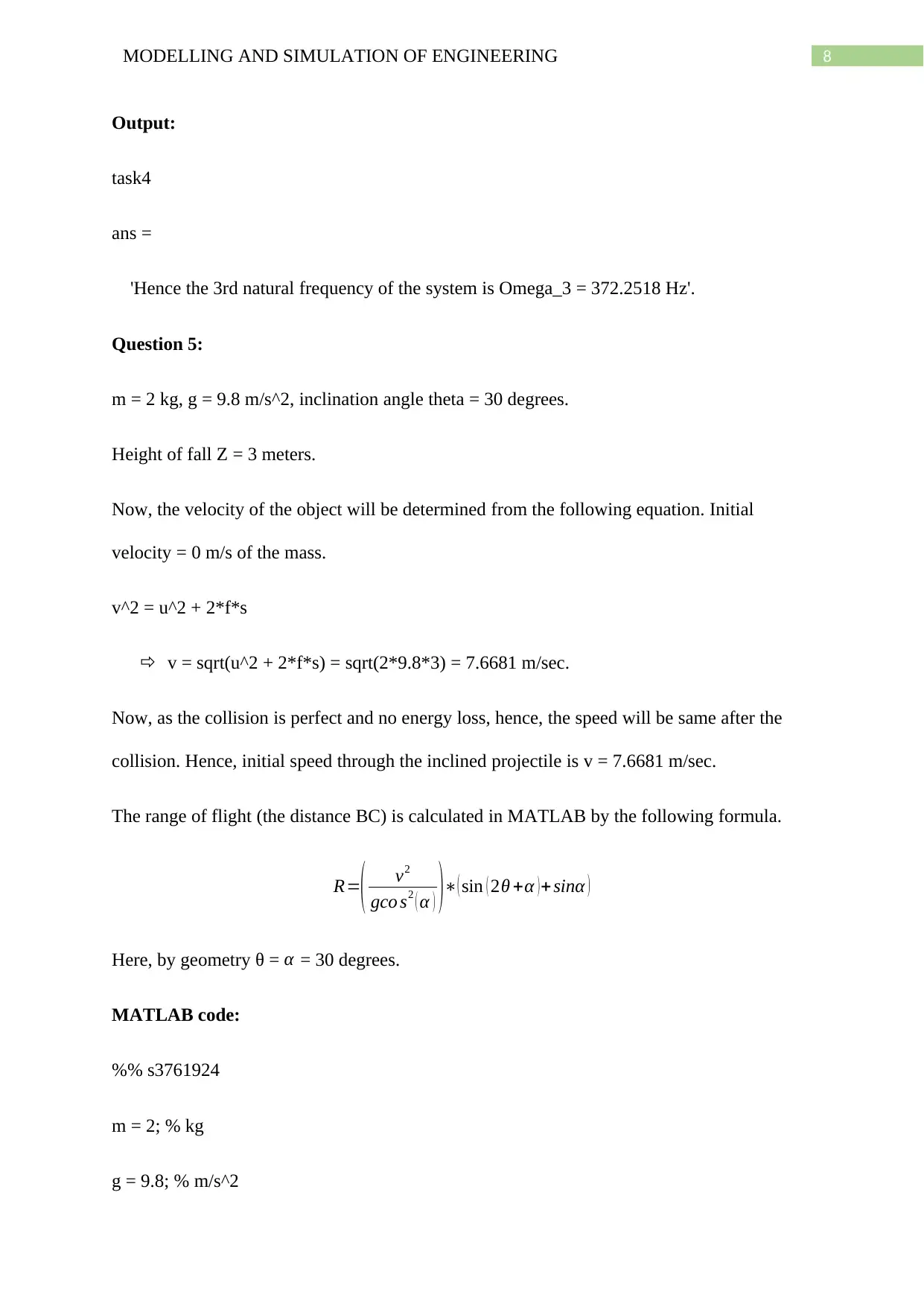
8MODELLING AND SIMULATION OF ENGINEERING
Output:
task4
ans =
'Hence the 3rd natural frequency of the system is Omega_3 = 372.2518 Hz'.
Question 5:
m = 2 kg, g = 9.8 m/s^2, inclination angle theta = 30 degrees.
Height of fall Z = 3 meters.
Now, the velocity of the object will be determined from the following equation. Initial
velocity = 0 m/s of the mass.
v^2 = u^2 + 2*f*s
v = sqrt(u^2 + 2*f*s) = sqrt(2*9.8*3) = 7.6681 m/sec.
Now, as the collision is perfect and no energy loss, hence, the speed will be same after the
collision. Hence, initial speed through the inclined projectile is v = 7.6681 m/sec.
The range of flight (the distance BC) is calculated in MATLAB by the following formula.
R=
( v2
gco s2 ( α ) )∗( sin ( 2θ +α )+ sinα )
Here, by geometry θ = α = 30 degrees.
MATLAB code:
%% s3761924
m = 2; % kg
g = 9.8; % m/s^2
Output:
task4
ans =
'Hence the 3rd natural frequency of the system is Omega_3 = 372.2518 Hz'.
Question 5:
m = 2 kg, g = 9.8 m/s^2, inclination angle theta = 30 degrees.
Height of fall Z = 3 meters.
Now, the velocity of the object will be determined from the following equation. Initial
velocity = 0 m/s of the mass.
v^2 = u^2 + 2*f*s
v = sqrt(u^2 + 2*f*s) = sqrt(2*9.8*3) = 7.6681 m/sec.
Now, as the collision is perfect and no energy loss, hence, the speed will be same after the
collision. Hence, initial speed through the inclined projectile is v = 7.6681 m/sec.
The range of flight (the distance BC) is calculated in MATLAB by the following formula.
R=
( v2
gco s2 ( α ) )∗( sin ( 2θ +α )+ sinα )
Here, by geometry θ = α = 30 degrees.
MATLAB code:
%% s3761924
m = 2; % kg
g = 9.8; % m/s^2
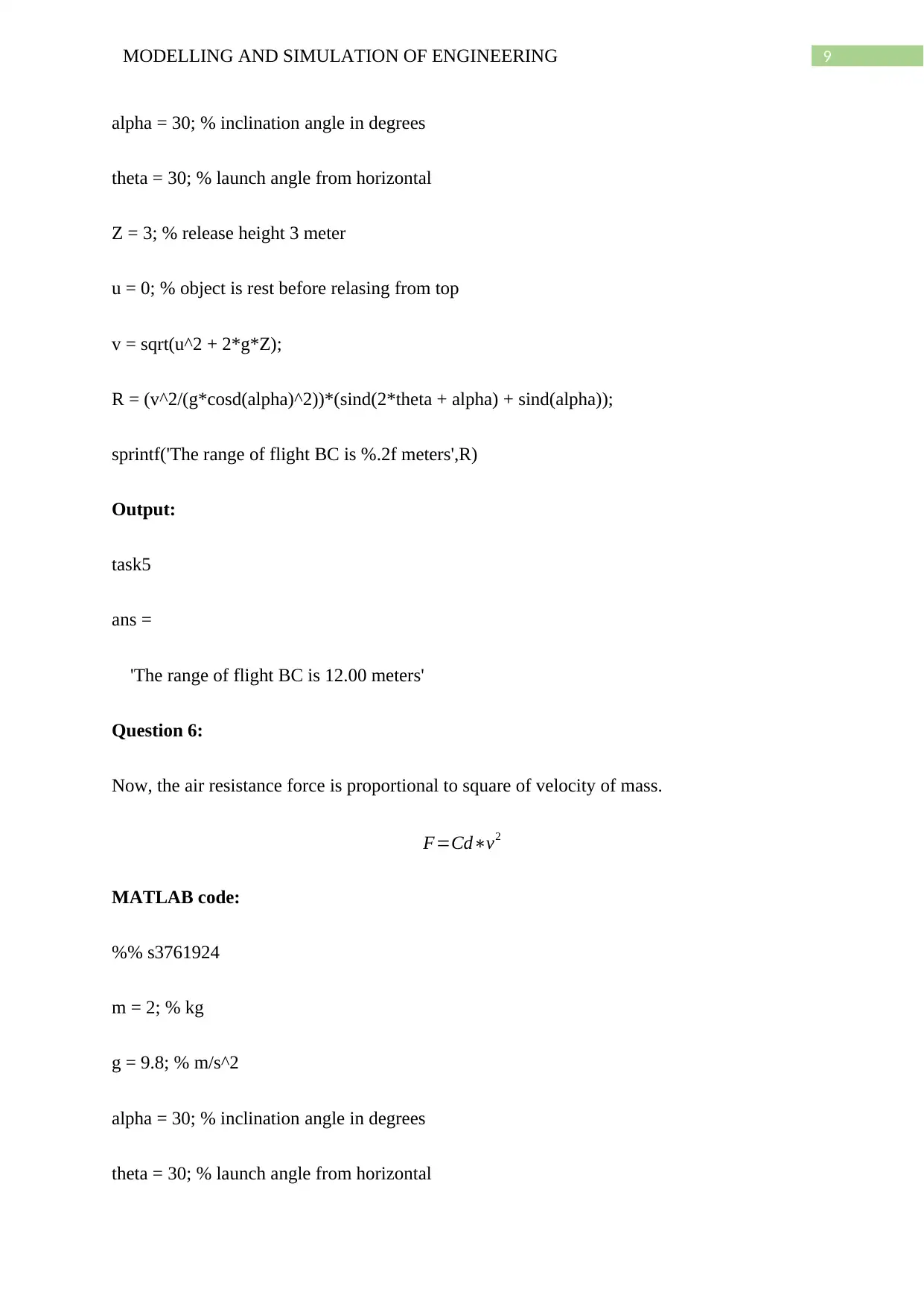
9MODELLING AND SIMULATION OF ENGINEERING
alpha = 30; % inclination angle in degrees
theta = 30; % launch angle from horizontal
Z = 3; % release height 3 meter
u = 0; % object is rest before relasing from top
v = sqrt(u^2 + 2*g*Z);
R = (v^2/(g*cosd(alpha)^2))*(sind(2*theta + alpha) + sind(alpha));
sprintf('The range of flight BC is %.2f meters',R)
Output:
task5
ans =
'The range of flight BC is 12.00 meters'
Question 6:
Now, the air resistance force is proportional to square of velocity of mass.
F=Cd∗v2
MATLAB code:
%% s3761924
m = 2; % kg
g = 9.8; % m/s^2
alpha = 30; % inclination angle in degrees
theta = 30; % launch angle from horizontal
alpha = 30; % inclination angle in degrees
theta = 30; % launch angle from horizontal
Z = 3; % release height 3 meter
u = 0; % object is rest before relasing from top
v = sqrt(u^2 + 2*g*Z);
R = (v^2/(g*cosd(alpha)^2))*(sind(2*theta + alpha) + sind(alpha));
sprintf('The range of flight BC is %.2f meters',R)
Output:
task5
ans =
'The range of flight BC is 12.00 meters'
Question 6:
Now, the air resistance force is proportional to square of velocity of mass.
F=Cd∗v2
MATLAB code:
%% s3761924
m = 2; % kg
g = 9.8; % m/s^2
alpha = 30; % inclination angle in degrees
theta = 30; % launch angle from horizontal
⊘ This is a preview!⊘
Do you want full access?
Subscribe today to unlock all pages.

Trusted by 1+ million students worldwide
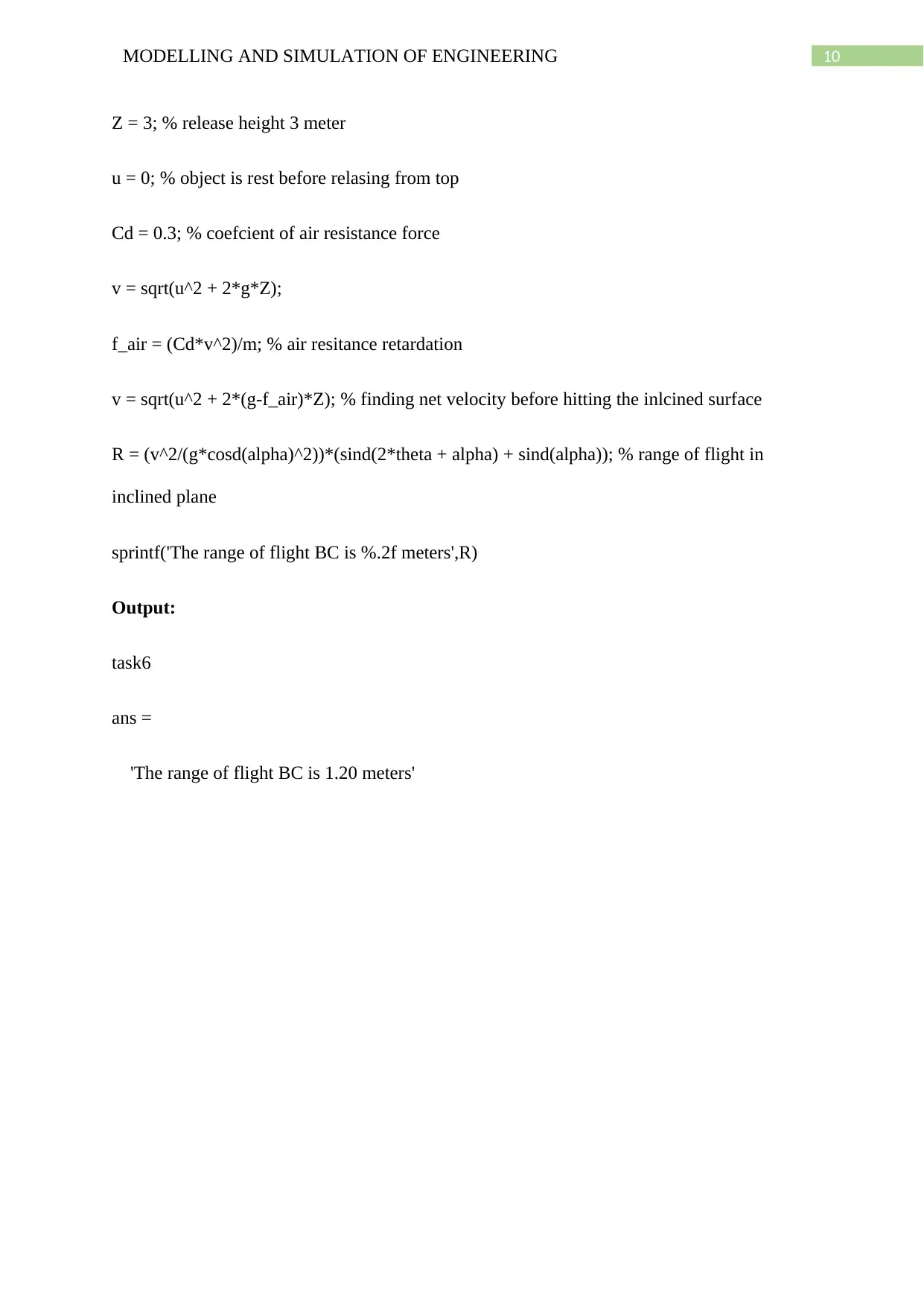
10MODELLING AND SIMULATION OF ENGINEERING
Z = 3; % release height 3 meter
u = 0; % object is rest before relasing from top
Cd = 0.3; % coefcient of air resistance force
v = sqrt(u^2 + 2*g*Z);
f_air = (Cd*v^2)/m; % air resitance retardation
v = sqrt(u^2 + 2*(g-f_air)*Z); % finding net velocity before hitting the inlcined surface
R = (v^2/(g*cosd(alpha)^2))*(sind(2*theta + alpha) + sind(alpha)); % range of flight in
inclined plane
sprintf('The range of flight BC is %.2f meters',R)
Output:
task6
ans =
'The range of flight BC is 1.20 meters'
Z = 3; % release height 3 meter
u = 0; % object is rest before relasing from top
Cd = 0.3; % coefcient of air resistance force
v = sqrt(u^2 + 2*g*Z);
f_air = (Cd*v^2)/m; % air resitance retardation
v = sqrt(u^2 + 2*(g-f_air)*Z); % finding net velocity before hitting the inlcined surface
R = (v^2/(g*cosd(alpha)^2))*(sind(2*theta + alpha) + sind(alpha)); % range of flight in
inclined plane
sprintf('The range of flight BC is %.2f meters',R)
Output:
task6
ans =
'The range of flight BC is 1.20 meters'
1 out of 10
Related Documents
Your All-in-One AI-Powered Toolkit for Academic Success.
+13062052269
info@desklib.com
Available 24*7 on WhatsApp / Email
![[object Object]](/_next/static/media/star-bottom.7253800d.svg)
Unlock your academic potential
Copyright © 2020–2025 A2Z Services. All Rights Reserved. Developed and managed by ZUCOL.





